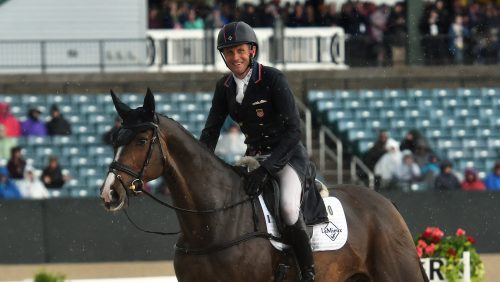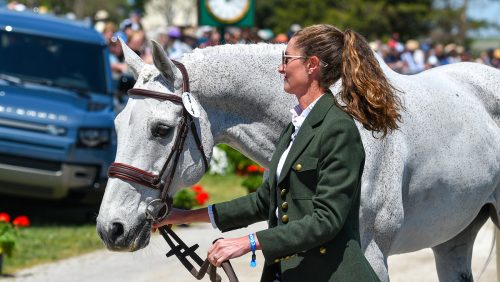I don’t think I would have believed it if someone had told me that my first takeaway from watching a clinic taught by Olympic gold medalist Charlotte Dujardin was that sometimes you need to kick your horse and go for a little “yeehaw.”
“The Americans are all going to go galloping and say, ‘Well Charlotte said…,’” she laughed after she had the third rider kick her horse forward into a gallop. “Weren’t you in Pony Club?” she asked? “You’re scrubbing, not kicking!”

Charlotte Dujardin took a turn on Dorian Dark while teaching. All Photos by Camilla Mortensen
With a sense of humor and sometimes acerbic wit Charlotte made clear over the first day of her two-day clinic that a horse needs to be forward, supple and ridden accurately in order to succeed at dressage.
She also threw in some other tidbits such as, “Round does not mean slow,” “Changes should be bigger than the canter,” and my personal favorite, “Short reins win gold medals.”
Saturday of the appropriately named “through the levels” clinic at Devonwood Equestrian just outside Portland, Ore., kicked off with a 4-year-old chestnut mare, Generosa S, going training level and finished with Northwest heartthrob cob, North Forks Cardi, at Grand Prix. Sunday a second group of horses will enter the arena.
The crowd watched as riders were chided for sloppy downward transitions (That’s disgusting,” she would call out in British-accented tones of disapproval or “That’s terrible!”). And they applauded when Charlotte praised the riders for figuring out how to execute a good corner or a canter pirouette.
Young Horses
Technical difficulties with the microphone at first led to some spooks and antics from Genarosa S and this allowed Charlotte to explain how asking a horse to stretch down is usually best left to late in the ride as the young ones can start off tight and tense and don’t understand the concept.

Generosa S, ridden by Brooke Voldbaek, had some spooky moments due to technical difficulties with the sound system, but worked through them.
The mare, like several of the horses at the clinic, had performed well in young horse classes. This led Charlotte to segue into her thoughts on young horse competitions: “I really hate young horse classes,” she said bluntly. “Judges want to see huge, flashy movement” rather than character and trainability.
Her young horses have “done rubbish” in those classes, she said. “I had great pleasure showing the judges I could take them to the international level and do Grand Prix on a horse they thought was not good enough.”
She rarely enters young horse competitions, she said, and when she does it’s to gain the horse some experience.
ADVERTISEMENT
On that note, a horse with a mechanically correct but not flashy trot might be the better prospect, she said, and over the course of the day Charlotte demonstrated how a trot can be improved when the horse learns to add suspension.
She and fellow team gold medal Olympian Carl Hester don’t pay more than 10-15,000 pounds for their prospects, she said, buying them as foals and young horses. Charlotte said she enjoys backing and starting the young ones and bringing them along herself.
Valegro, a horse with which Charlotte has won numerous world championships, was purchased for 5,000 pounds, she said (about $5,600) and Hester’s Nip Tuck was 2,500 euros.
“Through hard work and dedication you can get there,” she said later in the day. “It’s not all about the most money for the most expensive horse.”
When it comes to choosing a prospect, Charlotte says she looks for a good walk and canter. The walk should be loose, through and swinging, and the canter correct with good rhythm and adjustability. The trot? “The trot I can teach.”

Riders like Gail Redinger on the 5-year-old Formancier worked on improving their horses’ trot.
Horses can be allowed to make a mistake as they are learning, she said, and they learn through repetition.
Whips And The Voice
Prix St. George and Grand Prix riders got the same “kick your horse forward” treatment as those competing at the lower levels. Charlotte explained that one error riders often make is to carry a whip at all times, and then when they get to a competition in which can’t carry a whip, they get mystified when they are red-faced and sweaty from trying to get their horses to move. “He’s got a fever.” They try to explain their horses’ sluggishness, when in fact the issue is the horse is schooled to the whip.
Charlotte’s philosophy is that all horses should move off the leg—thus the schooling off the kick that she asked the riders to do. She allows a whip to be used when needed—for example when schooling flying changes, but other than that, riders were taught to have a horse that jumped forward off the leg.
Charlotte’s teaching and speaking style is candid, and she when an audience member asked about her use of the voice and the cluck, she said that it’s about having a horse that’s happy doing its job and she will use her voice to reward that. Sometimes, she admitted, she clucks in competition, though as far away from the judge as possible. That can be hard, she mused, at competitions where she has seven judges.
From training level to the upper level horses, Charlotte’s chiding, praise and advice created visible differences in each horse, and her explanations of what she wanted riders to do and why in order to achieve anything from a cleaner flying change to a better piaffe made sense not only to the upper level riders in the audience I spoke to, but to a dressage neophyte or two as well.
And everyone could appreciate her humor, even the riders who got a bit of a tongue-lashing when they repeated errors such as over-bending their horses left—something she says 90 percent of the riders do that she teaches. “You have to love your right right rein the way you love your left,” she told one rider. To another she said, “Quiet your hands, you look like you’re doing your knitting.”
ADVERTISEMENT
Boys Will Be Boys
Several of the eight or horses in the first day of clinic were mares and when Enya WS began to trot around Devonwood’s sandy outdoor ring, Charlotte admitted she is a proponent of mares. Geldings are straightforward, she told the crowd, and stallions are “lazy, piggy and too manly to live, why would you want another one?”
Mares on the other hand? “I love a good mare, a good mare gives you everything.” And pointed out mares can be bred while competing through embryo transfer.
She currently owns most of the shares in a 5-year-old mare she is excited about, Florentina. She said a recent win on the mare at the British young horse championships was emotional because it was her own horse, and she comes from a background of having to work her way up.
Passion And Tradition
When asked about bits and the fact that small and sturdy Welsh cob stallion North Forks Cardi was being ridden in Grand Prix work in a snaffle, not a double bridle, something that is allowed at national but not international competition, she said she thought that the requirement for a double bridle was a shame. Some horses, Charlotte said, have fat tongues or small mouths, which makes wearing the double bridle uncomfortable.
She reminded her audience that she is not afraid to buck the norm: She has long worn a helmet at the upper level, “You’re breaking tradition” she said people told her. ”I don’t care; safety comes first.” This statement was greeted with a round of applause.
Cardi, she said, was an excellent example of her belief that any horse can make it to grand prix. “All shapes and sizes can do it.” Looking at his neck, she observed, “You don’t have to work to get him on the bit, he’s just there.” It’s fantastic, she said, that a horse as different from the norm as Cardi “is showing us what he can do.”

Jessica Wisdom introduced the Grand Prix Welsh pony North Forks Cardi to Charlotte Dujardin.
Over the course of the day one of the things that stood out was Charlotte’s genuine love of the horses and her horsemanship. Horses have to be happy and enjoy the work was her refrain. She cautioned against riding a horse past the point where it is tired pointing out that they don’t learn when they are tired.
Over the years with her success with Valegro the pressure has increased, Charlotte said, but it’s a real pleasure to go into the arena and perform, especially when you are riding for your country. “My job is my passion,” she said.
Check back in tomorrow for coverage of Day 2 of the Charlotte Dujardin clinic.














